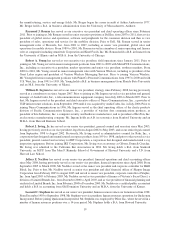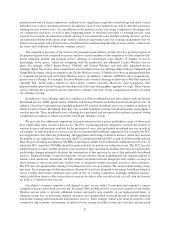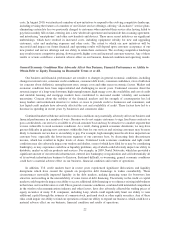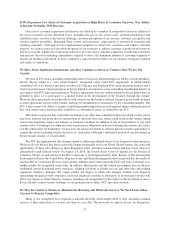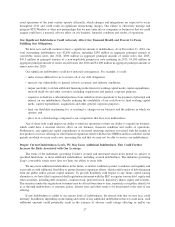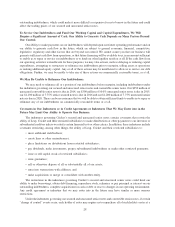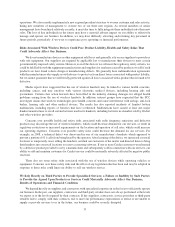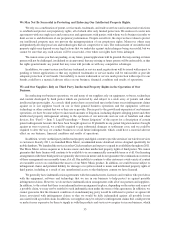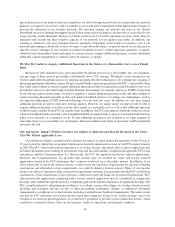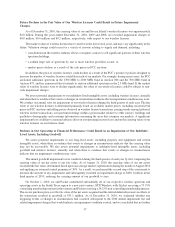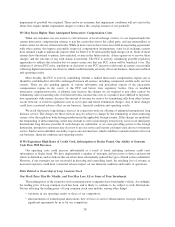Cricket Wireless 2010 Annual Report Download - page 35
Download and view the complete annual report
Please find page 35 of the 2010 Cricket Wireless annual report below. You can navigate through the pages in the report by either clicking on the pages listed below, or by using the keyword search tool below to find specific information within the annual report.purchase price equal to 101% of the principal amount of secured or unsecured senior notes, or 100% of the principal
amount of convertible senior notes, plus accrued and unpaid interest.
If we default under any of the indentures governing our secured or unsecured senior notes or convertible senior
notes because of a covenant breach or otherwise, all outstanding amounts thereunder could become immediately
due and payable. We cannot assure you that we would be able to obtain a waiver should a default occur. Any
acceleration of amounts due would have a material adverse effect on our liquidity and financial condition, and we
cannot assure you that we would have sufficient funds to repay all of the outstanding amounts under the indentures
governing our secured and unsecured senior notes and convertible senior notes.
Our Ability to Use Our Net Operating Loss Carryforwards to Reduce Future Tax Payments Could Be
Negatively Impacted if There Is an “Ownership Change” (as Defined Under Section 382 of the Internal
Revenue Code); Our Tax Benefit Preservation Plan May Not Be Effective to Prevent an Ownership
Change.
We have substantial federal and state NOLs for income tax purposes. Subject to certain requirements, we may
“carry forward” our federal NOLs for up to 20 years to offset future taxable income and reduce our income tax
liability. For state income tax purposes, the NOL carryforward period ranges from five to 20 years. As of
December 31, 2010, we had federal and state NOLs of approximately $2.1 billion, which begin to expire in 2022 for
federal income tax purposes and of which $0.3 million will expire at the end of 2011 for state income tax purposes.
While these NOL carryforwards have a potential to be used to offset future ordinary taxable income and reduce
future cash tax liabilities by approximately $800 million, our ability to utilize these NOLs will depend upon the
availability of future taxable income during the carryforward period and, as such, there is no assurance we will be
able to realize such tax savings.
Our ability to utilize NOLs could be further limited if we were to experience an “ownership change,” as defined
in Section 382 of the Internal Revenue Code and similar state provisions. In general terms, a change in ownership
can occur whenever there is a collective shift in the ownership of a company by more than 50 percentage points by
one or more “5% stockholders” within a three-year period. The occurrence of such a change generally limits the
amount of NOL carryforwards a company could utilize in a given year to the aggregate fair market value of the
company’s common stock immediately prior to the ownership change, multiplied by the long-term tax-exempt
interest rate in effect for the month of the ownership change.
The determination of whether an ownership change has occurred for purposes of Section 382 is complex and
requires significant judgment. The occurrence of such an ownership change would accelerate cash tax payments we
would be required to make and likely result in a substantial portion of our NOLs expiring before we could fully
utilize them. As a result, any restriction on our ability to utilize these NOL carryforwards could have a material
adverse impact on our business, financial condition and future cash flows.
On September 13, 2010, our board of directors adopted a Tax Benefit Preservation Plan to help deter
acquisitions of Leap common stock that could result in an ownership change under Section 382 and thus help
preserve our ability to use our NOL carryforwards. The Tax Benefit Preservation Plan is designed to deter
acquisitions of Leap common stock that would result in a stockholder owning 4.99% or more of Leap common stock
(as calculated under Section 382), or any existing holder of 4.99% or more of Leap common stock acquiring
additional shares, by substantially diluting the ownership interest of any such stockholder unless the stockholder
obtains an exemption from our board of directors. Because the number of shares of Leap common stock outstanding
at any particular time for purposes of the Tax Benefit Preservation Plan is determined in accordance with
Section 382, it may differ from the number of shares that we report as outstanding in our SEC filings.
Although the Tax Benefit Preservation Plan is intended to reduce the likelihood of an adverse ownership
change under Section 382, the Tax Benefit Preservation Plan may not prevent such an ownership change from
occurring and does not protect against all transactions that could cause an ownership change, such as sales of Leap
common stock by certain greater than 5% stockholders. Accordingly, we cannot assure you that an ownership
change under Section 382 will not significantly limit the use of our NOLs.
29


